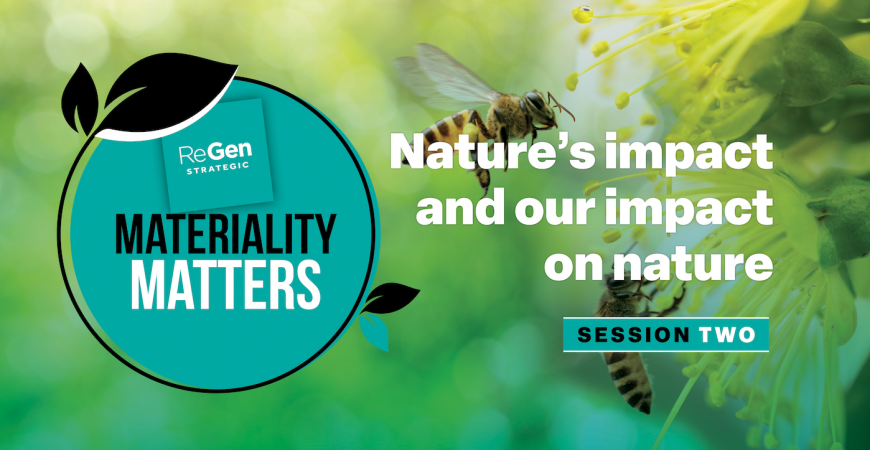The deterioration of nature and actions aimed at conserving, restoring and sustainably using it can present significant risks and opportunities for business, finance and society now and in the future. However, despite a common understanding of the importance of nature from a financial and economic perspective, very few organisations have applied a strategic process to identify, assess and disclose their nature related impacts which can be both negative and positive. Until recently, as with many notions of sustainability, this has largely been due to a lack of understanding about nature-related disclosures and a lack of emphasis from governments and regulators. However, as many are aware, this is rapidly changing.
TNFD framework
In 2023, the final Taskforce on Nature-related Financial Disclosure (TNFD) framework was released to provide organisations with a disclosure and risk management framework to identify, assess, manage and disclose nature-related issues.
This has made nature one of the ‘big three’ topics that are a key focus in many organisational sustainability strategies – along with climate and human capital – and it’s critical for organisations to understand their existing and upcoming responsibilities regarding nature-related disclosures. The Federal Government of Australia has even committed to a Nature Positive Plan which includes major reforms to the Environment Protection and Biodiversity Conservation Act 1999 (Cth) (EPBC Act) with a focus on moving away from current practices of “no net loss” to “net gain” or “nature positive.”
To uphold those nature-related responsibilities, it’s important to first understand what material topics fall within the nature category. Material topics within the category of ‘nature’ can include (amongst others) ecosystem integrity, biodiversity importance and physical water risks. Identifying which topics are the most important your business and your stakeholders will ensure your sustainability strategy is robust and positively received.
A materiality assessment will not only identify how nature may be a material topic for you, it will also provide an analysis of the financial and sustainability risks and opportunities nature will or potentially could have on your organisation.
We’ll break down some examples of what some nature-related risks and opportunities might emerge from this process.
Nature-related sustainability risks and opportunities
Nature-related sustainability risks can both directly and indirectly impact people and the planet. Direct impacts can be identified as operation-induced, such as polluted waterways from operations, which may impact a community’s access to fresh water or their food supply due to lack of suitable water systems. Sustainability risks can also be indirect, such as the clearing of native vegetation having long-term impacts to our climate, from destabilising ecosystems to potentially releasing ancient carbon sinks.
In parallel, when ‘nature’ is managed effectively, there are numerous sustainability opportunities for organisations to positively impact people or the planet. An organisation can utilise its resources to protect endemic species, potentially keeping them from the brink of extinction. Another opportunity may be enhancing rehabilitation efforts to move towards ‘nature positive’, a notion that you have not just returned the area to its original state, you’ve improved its biodiversity, carbon absorption and resilience.
To consider double materiality, it's critical an organisation also considers the financial impacts that nature may have on their organisation. Not managing nature effectively can present financial risks through areas such as higher costs of rehabilitation, cost of non-compliance through fines or additional resources required for lengthier approvals processes. Additionally, it’s important to consider how nature impacts may indirectly present financial risk. An example being how the depletion of native pollinators impacts the health and viability of crops, risking the source of income for a range of industries if the pollinators die out.
As with the sustainability risks and opportunities, there are significant financial opportunities that can be identified when effectively managing nature. Financial opportunities can include stronger stakeholder relationships driving brand loyalty, broader market reach and securing a social licence to operate. Opportunities can also be identified in the management of ‘flow on’ impacts, such as supporting pollinator protection programs, or investing in renewable resources to support ongoing operations in our changing world.
And perhaps the biggest financial opportunity for an organisation might come from adopting one of their sustainability opportunities as their organisational purpose. The importance of nature to our common future will only increase, and there will be great returns on offer for companies who can help people and the planet navigate this increasingly complex future.
Still unsure if this topic is relevant to you and your business? ReGen Strategic materiality assessments are delivered through our sustainability & ESG practice. Talk to us today about how we can deliver a bespoke materiality assessment that sets your organisation’s sustainability strategy and ESG reporting up for success.
 ReGen Strategic
ReGen Strategic